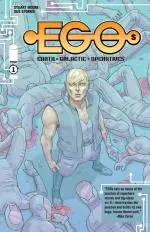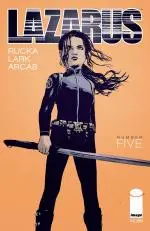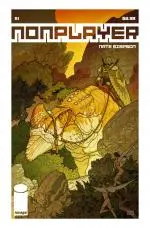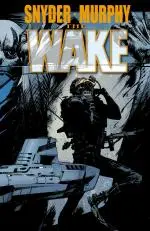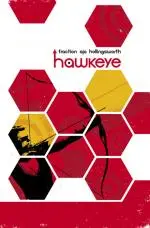The titles on this list all got the basics of great comics-making down with ease. They’re all well written and have stunning art. They also all have that perfect synergy between writing and art that makes for the best comics. They tell compelling stories and manage to engage and entertain in a scant 22 (or so) pages. But each of these books also have something else. Something unique that helps them level up and become unforgettable. Keep these things in mind when trying to give your own comics that extra something that will have people coming back again and again, cause these guys nailed it.
![]() 01. EGOS #1 by Stuart Moore and Gus Storms (Image)
01. EGOS #1 by Stuart Moore and Gus Storms (Image)
WHAT IT DID SO WELL: SUBVERT EXPECTATIONS
When I say subvert expectations I don’t mean tacking on a cliffhanger ending, or adding a twist that doesn’t make any sense whatsoever. I mean a story element that was clearly crafted from go and methodically planned out, not to give readers a quick and dirty “omg moment,” but to change up the themes and very soul of a book. Egos #1 begins as a simple “building the new team” book—a classic trope if ever there was one in superhero comics, but still highly enjoyable when done well. And Moore and Storms do it well. But when they completely flip the script partway through the book, they make what was already a good book into an exceptional one. It’s hard to do something genuinely new these days, and if you can find a way to take something that’s become a bit tired and make it entirely new, you will have hooked your readers powerfully.
[amazon B00HVGNYMC inline]
![]() 02. LAZARUS #5 by Greg Rucka and Michael Lark (Image)
02. LAZARUS #5 by Greg Rucka and Michael Lark (Image)
WHAT IT DID SO WELL: DEVELOP CHARACTER LAYERS
Lazarus was a good book from inception—with clever and imaginative world building, interesting characters, and intriguing plot points—but in issue #5, writer Greg Rucka found ways to make his lead character, Forever Carlyle, infinitely more interesting, giving her the kind of layers that most characters only dream of having. By expertly shifting back and forth in time between young Forever being trained to become her family’s Lazarus, and battle weary, present day Forever dealing with a string of bloody conflicts, Rucka draws effortless parallels between the girl she once was and the girl she has become. He highlights what has changed, and more importantly, the things that have not. At one point in the book, in the kind of scene that flawlessly develops character without overwritten narration or cheesy gimmicks, Forever is shot in the back by “the other side.” How she chooses to deal with this reality speaks volumes about her, instantly creating layers in an organic way and simultaneously delivering an unforgettable story of brutality mixed with bizarre kindness…in the right light. It’s exceptional character work, and the kind of moment that fans can point at to explain their utter devotion to a character.
[amazon B00H8VLHA6 inline]
![]() 03. NON PLAYER #1 by Nate Simpson (Image)
03. NON PLAYER #1 by Nate Simpson (Image)
WHAT IT DID SO WELL: WORLDBULDING
There’s a reason this book, despite having only had one issue ever released (in 2011, #2 is supposedly forthcoming), still makes this list. It’s because it has some of the most fully developed, bonkers cool worldbuilding I’ve ever experienced in a comic, certainly in a first issue. Every detail is considered, from the big picture ideas to the minutia, and yet that detail never gets in the way of telling a fascinating character-based story. Simpson’s Non Player in not necessarily the most original idea in the world, with its technologically advanced but somewhat crappy future and highly advanced “video-gaming,” but the execution is simply unparalleled. Simpson is both the writer and artist, and as such he never over-writes, but lets his insanely rich visuals do most of the talking, and that’s to the book’s benefit. Non Player is never clunky or forced, but rather seamless and organic. This book made such a strong impression that it’s still beloved by fans anxiously waiting the second installment (including yours truly), and on the strength of a single issue was able to land a film deal with Warners. That is some damn fine worldbuilding, kids. Read and learn. Read and learn.
[amazon B004V9ULN2 inline]
![]() 04. THE WAKE #5 by Scott Snyder and Sean Murphy (Vertigo)
04. THE WAKE #5 by Scott Snyder and Sean Murphy (Vertigo)
WHAT IT DID SO WELL: REFUSE TO THINK SMALL
One of the greatest things about comics as a medium, like prose, and unlike film and television, is that there is simply no limit to what you can do. It constantly surprises me when comics make a safe choice. Why be safe? You can do ANYTHING YOU CAN IMAGINE. Scott Snyder and Sean Murphy’s The Wake is a great example of the refusal to think small, and though it’s true of the entire series (thus far), it really reaches it’s peak (again, thus far) in issue #5. The fifth issue of the ten issue mini-series marks the end of part one, and jumps from what is essentially “present day” and a potentially apocalyptic event just beginning (which our heroes have been fighting against) to a future after those heroes have failed to save the world from said event. Right off the bat, investing five issues in people racing to save the world only to let them fail is bold thinking. But to then race forward in time to pick up the thread in a vastly different apocalyptic world, well, there’s nothing small about that. Snyder’s tale spans literally millions of years and holds nothing back. More comics, hell, more stories period, should remember to hold nothing back. It’s invigorating and inspiring to read something that risks everything on the page. That goes for it with every moment.
[amazon B00GHZC81Q inline]
![]() 05. HAWKEYE #13 by Matt Fraction and David Aja (Marvel)
05. HAWKEYE #13 by Matt Fraction and David Aja (Marvel)
WHAT IT DID SO WELL: RESONATE EMOTIONALLY
So many of us, myself included, are afraid to get emotional in our writing. All writing exposes you to a degree, but attempting to make someone really care, to really feel thanks to your writing, that's risky. The same way it's risky to emotionally invest and connect to people in the real world. But in both, the payoff is of course, significant. It’s an incredibly tough balance to strike in your writing — to make people care and not get an eye roll. But what’s more rewarding than genuinely moving people? It’s the biggest risk and thus the biggest payoff. One of the most moving comics I've read in recent memory was last year’s Hawkeye #13, a book that took a funeral — a frequently cliché and poorly executed event (and device) — and made the grief absolutely palpable on the page. It was a particularly risky move because Hawkeye is generally a light book, high on jokes and action. However, beneath that veneer of humor the book has always had a deep and rather tragic soul. Fraction and Aja tore open that soul in issue #13 to expose the raw nerve in both subtle and unsubtle ways. The result was a beautiful and important comic, the kind that sticks with you long after you’ve forgotten all the jokes you loved.
[amazon B00FQSRJ9Q inline]
What about you? What did I miss? What great comic book did you read that had an element that allowed it to level up?

About the author
Kelly Thompson is the author of two crowdfunded self-published novels. The Girl Who Would be King (2012), was funded at over $26,000, was an Amazon Best Seller, and has been optioned by fancy Hollywood types. Her second novel, Storykiller (2014), was funded at nearly $58,000 and remains in the Top 10 most funded Kickstarter novels of all time. She also wrote and co-created the graphic novel Heart In A Box (2015) for Dark Horse Comics.
Kelly lives in Portland Oregon and writes the comics A-Force, Hawkeye, Jem & The Holograms, Misfits, and Power Rangers: Pink. She's also the writer and co-creator of Mega Princess, a creator-owned middle grade comic book series. Prior to writing comics Kelly created the column She Has No Head! for Comics Should Be Good.
She's currently managed by Susan Solomon-Shapiro of Circle of Confusion.
